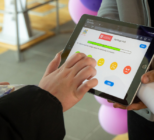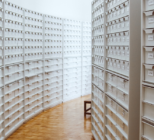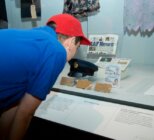What can Bluetooth Low Energy (BLE) iBeacons do for visitors with disabilities?
Bluetooth Low Energy (BLE) Beacons, or beacons, are small devices with ultra-long battery lives (2-5 years), which transmit a unique ID at regular, short time intervals (every few seconds) over a (configurable) distance range. And that’s all they do: sit and call out who they are.
The interesting thing about beacons is that any Bluetooth 4.0-enabled mobile device that enters the beacon’s range can then hear that ID information and, if armed with a clever beacon app, the device can figure out how close to that beacon it is and perform a suitable action, for example play a piece of audio related to that location, unlock a reward, ask the user a question, etc. What’s exciting about this is the user need not know any of the beacon-device greeting rituals, and need not do anything for the device to then take that action: if Bluetooth is on, information just appears as the user approaches the beacon.
This removes the layer of user interaction that is necessary with other indoor location technologies like QR or Near Field Communication, allowing the user to focus on the interaction with the actual content of the app. Beacons are being rolled out for use in retail around the world; there is now growing interest in how this new technology can be applied to museums and heritage sites.
What research have you been working on with iBeacons?
I have been leading the research strand of the Leicester Castle tells its story project, which developed a beacon app for Leicester Castle. Our research included visitor studies and trials of the app, the findings of which fed into design iterations. I worked on the project with Dr Maria-Anna Tseliou, Research Associate, and with project partners Leicester City Council (project lead), Locly (technical partner), and Metro-Boulot-Dodo (content developers). The project run from Oct 2014 to Sep 2015 and we are currently finishing up our final report for Nesta. Leicester Castle is a Grade I listed building with a medieval Great Hall that contains two mid-Victorian courtrooms. It has a rich and varied history, having been used to host Parliament on several occasions and the visits of various kings, including King Richard III. The courtrooms were witness to hundreds of trials including that of the notorious Green Bicycle Murder. Many famous people were associated with the building including Simon de Montfort, Chaucer and JM Barrie who was a courtroom reporter.
Beacons are placed discretely around the two Victorian courtrooms and down in the cells and a beacon app for iOS and Android smartphones and tablets is looking out for these beacons to present visitors with historical content through a series of tours and trails. Two of these are audio tours; the Green Bicycle Murder audio tour targets those visitors who are concerned about a mobile device requiring all their attention, and dislike or are physically unfit for consuming textual/visual information on a mobile device (e.g. visually impaired). The tour tells the story of the trial for the murder of Bella Wright which took place in the Castle Courts in 1920. The story is an emotive dramatisation of the trial narrated by the victim, while a ‘meta-narrator’ guides visitors through different locations in the courtroom and invites them to enter the dock, sit on the jury bench and stand in the witness box to hear key moments of the trial.
The Court Audio Trail presents the Castle’s recent history as a Crown Court from 1821 until 1992 and it includes oral testimonies collected from 15 individuals that worked in the Courts. While exploring the courts visitors listen to those memories that relate to specific areas of the court e.g. the visitor can explore the cells while hearing from a retired policemen describing how the criminals were detained. At each location a narrator tells the visitor where they are (“In the area below the judge sits the court clerk”), then related oral testimonies follow.
How could iBeacons be used to benefit the visually impaired people?
The Youth Forum of the Royal London Society for Blind People (RLSB) and ustwo, a global digital product studio, collaborated to produce Wayfindr, an open standard for creating consistent, seamless and reliable experiences of digital navigation in the built environment. Wayfindr empowers vision impaired people to travel independently. The standard includes guidance on the design of audio instructions, interaction design, and reassurance and orientation for visually impaired users, as well as guidance for integrating beacons into the built environment.
Leicester Castle’s beacon app was not designed specifically for visually impaired visitors. However, tours like the Green Bicycle and the Court Audio Trail are prime candidates for visually impaired-friendly interpretation. At present the Court Audio Trail does not offer any navigational guidance to users; it allows them to explore the physical space freely, as they would normally do – appropriate audio content simply starts playing when they enter a beacon’s range. By following a standard like Wayfindr it would be possible to add a layer of navigation functionality powered by the beacons to enable visually impaired visitors to enjoy content that would otherwise be hard to access. The Green Bicycle tour already guides users where to go next; adding appropriate audio instructions how to get there would, again, make this tour accessible to the visually impaired. Beyond interpretation, beacons can make all areas of the built environment easier to navigate and negotiate: they can direct visitors with visual or other disabilities to accessible toilets, ramps, or Braille panels.
How are iBeacons currently being used in museums?
Beacons are only a few years old and their potential in heritage both for disabled and non-disabled visitors has only just started to be explored. There are already many examples of museums using beacons in various ways. The New Museum in New York hosted an exhibit that used beacons to simulate a minefield experience for visitors; the National Slate Museum is using beacons to provide visitors with location-specific content from the museum collections; The Brooklyn Museum is using beacons to tell the staff who are answering questions which gallery a visitor is standing in and what works of art are nearby; Amsterdam’s Poetry Festival used beacons to activate “secret” poems and give attendees location- and time-specific information. Each implementation adds to our scoping of their potential and we can expect to see more beacon experimentation in the coming years, particularly as new devices with added sensors (for light, colour, acceleration, temperature, humidity, motion, etc.) become available. Combined with developments in other fields such as 3D audio, we can look forward to some truly innovative accessibility enhancements.
All partners on our project are looking at follow on beacon projects. E.g. the City Council are considering expanding the beacon offer around the city, possibly with the Heritage Interpretation Panels project. At the University we have acquired a 2-year Locly sandpit kit subscription, and we will be looking to develop pilot and proof of concept projects, as well as the development of participatory beacon design methods. It is still early days, but my plan is to focus on projects that encourage active participation in (local) heritage.
What are the challenges with using iBeacons?
Like every new technology, beacons have come with teething problems: managing large numbers of beacons can be an all but trivial task; the technical specification of the building (e.g. material and thickness of walls) can affect installation and calibration; interference from large numbers of visitor bodies can present a much different picture to the one tested in an empty building and many issues are addressed by this blog about Brooklyn Museum installing beacons. But like many other technologies in the past, we can expect that these problems will gradually resolve as new generations of devices become available. Meanwhile, continuing our experimentations with disability-friendly, beacon-based interpretation approaches will help ensure that we make the most of this promising technology for all visitors.









